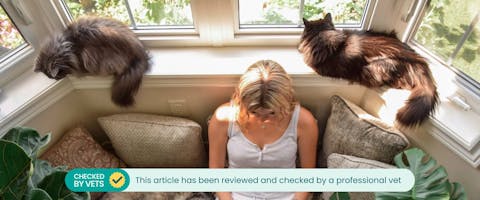13/02/2024
Landed a pet sitter gig with a paw-rent who’s got not one, not two, but a whole crew of cats? It’s definitely squad goals, but cat sitting for multi-pet households can also feel a little daunting, as it’s easy to worry about ruffling some whiskers, stepping on some paws, and accidentally causing a whole lot of feline fuss. Your pet sitting skills are about to be put to the test; that’s why we’re sharing our top tips on cat sitting for multi-pet households, including preparing for the house sit and how to care for your purr patrol.
Understanding responsibilities
As well as explaining how many furry friends need looking after, pet parents should give cat sitters a clear set of instructions before leaving, including information about the following:
- Feeding schedules and daily routine
- Where their furry friends like to sleep
- Whether they’re indoor or outdoor cats
- Whether they need any medication or special care
- How long the cats can be left alone
Having a clear understanding of the responsibilities from the get-go ensures things run as smoothly as possible while the pet parents are away.
Getting to know the cats
Every tail has a story to tell, so it’s also important for pet parents to provide an insight into the personality traits of their furry friends. Do they prefer being left to their own devices or will they spend the day curled up in your lap? Are they likely to go off exploring overnight or would this be unusual? Keep in mind that while Cookie the cat might love a scratch behind the ears, her furry brother or sister may not feel the same. Take things slow at first, and remember, it’s far easier to start off on the right foot rather than going back to repair things at a later date.
Trending posts
Purr-use some of the top blogs our members have been loving this month- Top male dog names for your new furry friendGot a new furry family member in your pack? Check…

- Top female dog names for your new fluffy palWelcoming a new pooch into your family? Explore…

- 120+ gray cat names your silver feline will loveRecently welcomed a fluffy gray bundle of joy into…

- What are normal pet sitting rates?Discover the average pet sitting rates for animals…

- Unique dog names to stand out from the packDare to be different with our list of the best…

Establishing a routine
For things to run smoothly, pet parents need to give pet sitters a rough idea of their routine. This will usually be along the following lines:
- Daily litter box maintenance
- Replenish food and water twice a day
- Clean food bowls every 2-3 days
- Administer medication when necessary
- Groom the cats frequently with a brush (some cats need more or less help with grooming depending on their age, fur type, and personal hygiene habits)
- Frequent playtime and opportunities for exercise (this will vary depending on the energy levels of the cats)
- Vacuum/sweep every 2-3 days (depending on how much hair the kitty cats lose)
Continuing with the same routine should help feline friends feel more comfortable and reduce the chance of separation anxiety while pet parents are away.
Keeping everyone happy
Each furry family member deserves their fair share of care and attention, and it’s essential to stay tuned to their individual preferences and boundaries. As a pet sitter, ensuring every kitty cat in the household is mentally and physically stimulated with toys and games will take more time than it would in a single-cat household.
Prioritizing safety
In the hustle and bustle of a household with multiple pets, prioritizing the safety of our feline friends becomes even more important. As the number of purr pals increases, so does the potential for mess, and staying on top of the cleaning is key. When cat sitting for multi-pet households, you’ll need to devote more time to cleaning out the litter boxes, filling up food and water bowls, and ensuring each kitty gets the grooming attention they deserve. Beyond cleanliness, creating a safe environment involves more than just removing potential hazards. Cat sitters also need to ensure kitties have access to the safe spaces created by their pet parents at all times, so they can retreat for a bit of “me time” whenever they need it.
Dealing with conflict
You might be familiar with the saying “fight like cats and dogs”, but navigating disputes between feline friends is an art of its own. If you notice one of the multiple animals under your care is nearing the end of their tether, they must have their own space to retreat to - this might mean closing the door to their room or cornering off an area so they can’t be disturbed.
Emergency situations
Even the best-laid plans can go awry, and cat sitters should be able to recognize signs their furry friend is unwell or injured. When professional help is needed, cat sitters must have emergency contact details for both the pet parents and their vet. For times when an extra helping hand is needed, remember that TrustedHousesitters provides access to a 24/7 vet advice line, which sitters can use at any point during their stay.
So from divas demanding their sunlit thrones to mischief-makers orchestrating midnight escape plans, there’s never a dull moment when cat sitting for multi-pet households! If you want to find out more about joining our community of animal loving sitters, explore all things house and pet sitting over on our “How it works” page.
Meet our veterinary expert, Emma
This article has been checked by veterinarian Emma Chandley, BVetMed MRCVS PGCertSAS. Emma graduated from the Royal Vet College in London in 2011. She has a keen interest in surgery and went on to do a postgraduate certificate in small animal surgery and was then awarded advanced practitioner status in the same discipline.

